Crucial Ballistix Tactical LP and Crucial Ballistix Sport VLP Dual-Channel DDR3 Memory Kits Review

The new DDR3-1600 memory kits from Crucial are quite interesting for two reasons. On the one hand, these are low-profile memory modules. On the other hand, they meet the DDR3L standard requirements. But does it have its value for overclocking fans?
Introducing each of our recent reviews of memory modules for enthusiasts we have invariably stressed the fact that DDRS SDRAM makers are having a really bad time. Prices on their produce have stabilized at an indecently low level (although there’s an upward trend in January it cannot really change the situation at large). Moreover, the whole PC industry is currently going through a crisis due to decreasing sales volumes. On the other hand, end-users should be glad about that since the developers have to come up with original and customer-oriented products to survive on the highly competitive market. That’s why we can see a variety of memory modules that differ much more than just in the color of their heatsinks.
There are two traditional ways to enhance memory modules and make them more attractive products. The first way is to improve their specifications such as clock rate and timings. And the second is to improve the exterior design by equipping memory modules with originally shaped heatsinks, highlighting or some kind of indicators. It’s impossible to move on in these directions infinitely, though. For example, memory modules have already reached the limit of their speed. Clock rates above DDR3-2400 and DDR3-2666 have no practical worth since they are not supported by memory controllers of today’s CPUs. Lowering memory timings doesn’t affect real-life performance much, either. As for exterior design, it is not so easy to sell beautiful memory modules in large quantities. There are not so many users ready to pay extra for the looks of their computer components. And it’s also hard to make users switch over from brands they have been loyal to.
Memory makers have found a third way to progress, though. It has been shown by Crucial, a daughter firm of Micron Technology, the well-known manufacturer of memory chips. Crucial puts an emphasis on convenience and low power consumption instead of high clock rates and exterior design. The outcome of this approach can be seen in the low-profile modules of the Ballistix Tactical and Ballistix Sport series. They are not exceptional in terms of speed but are guaranteed to fit into any computer configuration irrespective of what CPU cooler you use. Besides, such memory complies with the DDR3L standard, which means reduced voltage.

Both properties can appeal to enthusiasts. The reduced default voltage suggests high overclocking potential whereas the compact form-factor is a huge advantage for people who have to deal with bulky CPU coolers whose heat pipes tend to block the mainboard’s DIMM slots. That’s theory, but what about practice? We can check it out as Crucial have been kind to offer us two dual-channel 16GB memory kits of their new low-profile modules.
Testing Participants
Crucial Ballistix Tactical LP DDR3-1600 2x8GB (BLT2K8G3D1608ET3LX0)
All enthusiast-grade memory currently offered by Crucial is marketed under the Ballistix brand. Such products feature high speeds and heatsinks for cooling. The heatsinks may vary in shape and exterior design and currently exist in three modifications called Sport, Tactical and Elite. The Sport series is targeted at simple configurations, the Tactical series supports XMP and the Elite series includes top-speed DDR3 SDRAM with massive heatsinks and temperature monitoring. The Tactical modules are also available in the Tracer version with LED indicators of activity.
Recently, the nomenclature has been extended so there are now Low Profile (LP) modules in the Sport and Tactical series. Crucial means that such sticks are at least 15% smaller than standard and can be used in configurations with hard-to-access DIMM slots. As a matter of fact, products of this kind have long been available in stores but we haven’t yet seen overclocker-friendly low-profile modules with heatsinks. That’s why the Crucial Ballistix Tactical LP kit is quite an original view.
It is shipped in a blister wrap which seems to be designed for standard-size DDR3 modules. So you can easily see how slim the Ballistix Tactical LP really is.
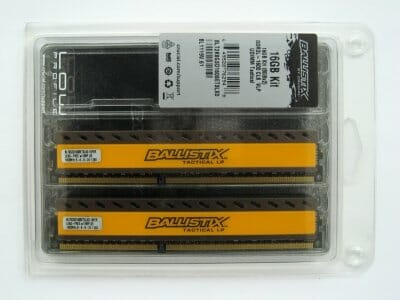
The low-profile modules with heatsinks look funny on closer inspection. Even though the heat-spreading plates rise above the PCB by a few millimeters, the total height is only 26 mm. Thus, they are lower than ordinary heatsink-less DIMMs that have a typical height of 30 mm. And, of course, the Ballistix Tactical LP is far more compact in comparison with heatsink-equipped memory for enthusiasts.
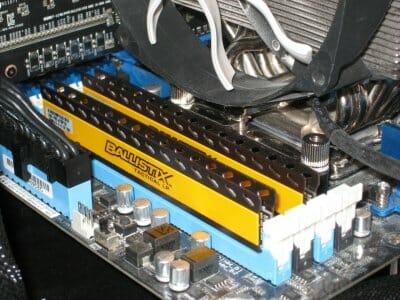
Crucial has tried to endow these modules with everything peculiar to overclocker-friendly products. The Ballistix Tactical LP features eye-catching and efficient heatsinks that cover the chips and are fastened to them with heat-conductive dual-sided adhesive tape. The steel bars are perforated at the top to improve the air flow and serve as an aesthetic element. Their appearance is also enlivened by the yellow plastic stickers that go along each heatsink and carry a black-painted name of the series. Of course, this cooling system cannot compete with the heavier heatsinks of conventional full-size modules, but the Ballistix Tactical LP doesn’t actually produce that much heat.
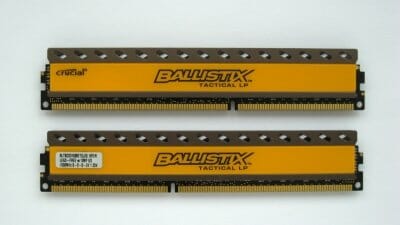
Why? Because this memory complies with the DDR3L standard which ensures reduced power consumption and heat dissipation by means of lowering voltage by 10% (to 1.35 volts). Crucial notes that the memory can also work at the standard voltage of 1.5 volts.
The official specs of the Crucial Ballistix Tactical LP DDR3-1600 2x8GB memory kit (BLT2K8G3D1608ET3LX0) are as follows:
- Dual-channel kit consists of two memory modules, 8 GB each;
- Nominal frequency: 1600 MHz;
- Timings: 8-8-8-24-2T;
- Supports XMP;
- Voltage: 1.35 V or 1.5 V.
It must be noted that even though the Ballistix Tactical LP DDR3-1600 is marketed as an overclocker-friendly product, it doesn’t offer anything exceptional in terms of specs. 1600 MHz is rather a standard frequency now and the aggressive memory timings can’t change that. However, the manufacturer has implied to us that the high potential of this product is going to show up in practical tests.
You can usually get a good notion of that potential by checking out the components a memory module is made of. The heatsinks of the Ballistix Tactical LP cover an austere-looking black PCB with chips from Micron, Crucial’s parent company.
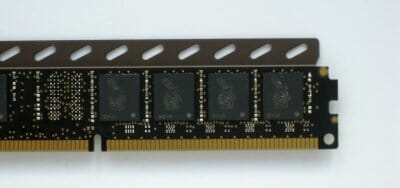
Unfortunately, the chips have been rebranded with a Ballistix logo and do not reveal anything about the modules.
The two XMP profiles are more informative. One configuration refers to 1.35 volts and the other, to 1.5 volts. The timings are identical in both cases, suggesting that this memory is rather indifferent towards voltage. That’s good for overclocking. You don’t have to bother about unpleasant consequences of your increasing the voltage above the default level.
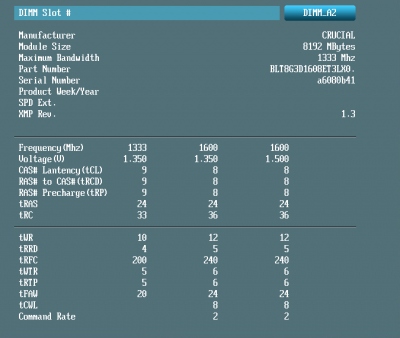
Crucial provides a lifetime warranty for all its memory modules for enthusiasts. All of them undergo presale testing. Besides, compatibility is ensured by checking out each new memory series with a large number of different mainboards.
Crucial Ballistix Sport VLP DDR3-1600 2x8GB (BLS2K8G3D1609ES2LX0)
This second kit of low-profile Ballistix memory is referred to as Sport. It is positioned lower than the Ballistix Tactical LP series. However, the Ballistic Sport VLP turns out to be even more exciting because the VLP abbreviation stands for Very Low Profile. The extremely compact memory offered by Crucial in the Sports series has no alternatives from this or other manufacturers.
Our dual-channel DDR3-1600 kit consisting of two 8GB modules is packaged like the Ballistix Tactical LP series. It is shipped in a unified blister wrap which has a lot of free space left. The memory sticks are firmly fixed inside, though.
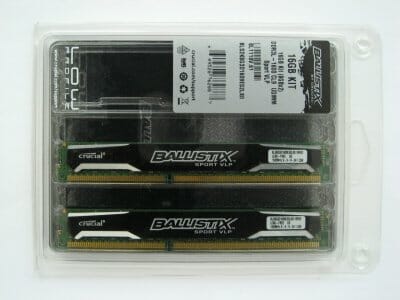
Some similarity can be traced to the Ballistix Tactical LP series in the appearance of these modules. In both cases we have a compact PCB which is a mere 20 mm in height but the Tactical LP series is taller due to the heatsink. The Sport VLP series has simpler cooling and its heatsink doesn’t increase the overall height of the module. As a result, each module is no higher than 20 mm. In fact, such modules are going to be somewhat lower than the DIMM slot latches when installed.
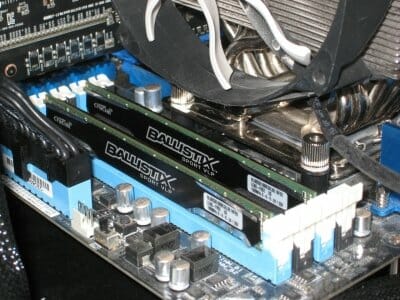
The heatsinks are surely less efficient than those of the Tactical LP series. In fact, they are nothing more but slim bars of aluminum. Black-anodized, they are shaped intricately and feature a shining edging and a logo with series name right in the center. So their main purpose seems to make the Ballistix Sport VLP modules look like a premium product for discerning users.
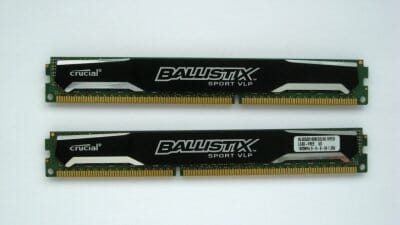
As a matter of fact, modules of this type do not call for dedicated cooling. Besides the rather low clock rate of DDR3-1600, they work at reduced voltage. Like the Tactical LP, the Sport VLP complies with the DDR3L standard and thus can work at 1.35 volts.
The heatsink is not the only point of difference between the two series, though. The Ballistix Sport VLP DDR3-1600 2x8GB kit is designed for a different operating mode as described in its specs:
- Dual-channel kit consists of two memory modules, 8 GB each;
- Nominal frequency: 1600 MHz;
- Timings: 9-9-9-24-2T;
- Supports XMP;
- Voltage: 1.35 V or 1.5 V.
The Sport VLP has relaxed timings with a CAS Latency of 9 whereas the Tactical LP has a CAS Latency of 8. Otherwise, the modules are identical in their specs as well as in their XMP profiles.
The XMP profiles describe two operating modes with voltages of 1.35 and 1.5 volts. From the manufacturer’s point of view, both low-profile memory kits perform identically in DDR3L and DDR3 modes. The former mode is preferable in practical terms as it helps reduce power consumption. The other XMP profile is an invitation to overclocking. It guarantees that if you increase the voltage of your Ballistix Sport VLP (or Tactical LP) modules, they won’t be damaged.
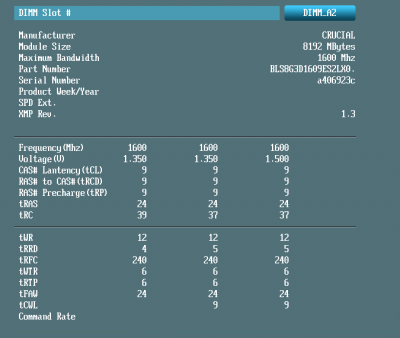
Besides the two XMP profiles, there is an SPD profile describing DDR3-1333 mode to ensure compatibility with a vast majority of existing computer platforms.
As for chips employed, we cannot say anything specific again. They lack their original marking. The only thing we know about them is that their manufacturer is Micron.
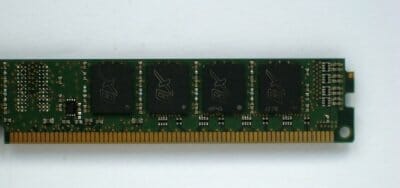
By the way, the Ballistix Sport VLP and Tactical LP modules have the same PCB design and only differ in the color of the PCB. We suspect that both are identical in terms of hardware, being differentiated by the exterior design, XMP profiles and official specs. Let’s check this out in practical tests, though.
Testbed Configuration
We are going to test low-profile Crucial Ballistix memory kits in an LGA 1155 system built on Asus P8Z77-V Deluxe mainboard based on the newest Intel Z77 Express chipset. Since overclocking memory modules are primarily purchased by enthusiasts, we also used Intel Core i5-3570K processor overclocked to 4.5 GHz.
As a result, the complete list of hardware and software components in our testbed looked as follows:
- CPU: Core i5-3570X, overclocked to 4.5 GHz (Ivy Bridge, 4 cores, 6 MB L3);
- CPU cooler: NZXT Havik 140;
- Mainboard: ASUS P8Z77-V Deluxe (LGA 1155, Intel Z77 Express);
- Memory:
- Crucial Ballistix Tactical LP BLT2K8G3D1608ET3LX0 (2×8 GB, DDR3-1600, 8-8-8-24);
- Crucial Ballistix Sport VLP BLS2K8G3D1609ES2LX0 (2×8 GB, DDR3-1600, 9-9-9-24).
- Graphics card: Nvidia GeForce GTX 680 (2 GB / 256 bit GDDR5, 1006/6008 MHz);
- Drive: Intel SSD 520 240 GB (SSDSC2CW240A3K5);
- Power supply unit: Corsair AX760i (80 Plus Platinum, 760 W);
- Operating system: Microsoft Windows 7 SP1 Ultimate x64;
- Drivers:
- Intel Chipset Driver 9.3.0.1026;
- Intel Management Engine Driver 8.1.2.1318;
- Intel Rapid Storage Technology 11.7.0.1013;
- NVIDIA GeForce 310.90 Driver.
Overclocking
As we showed in our special review of the memory controller in modern LGA1155 CPUs, it is the operating frequency of dual-channel memory kits that has the biggest effect on the platform’s performance. Therefore, increasing it above standard levels is the key feature of overclocker-friendly memory kits that helps ensure an additional performance boost.
The tested Crucial Ballistix Tactical LP and Crucial Ballistix Sport VLP look quite promising in this respect. Although their nominal operational modes are quite common, these kits offer broad flexibility in terms of increasing the voltage, which inevitably affects the overclocking potential. Besides, they are built with high-quality Micron chips and use efficient heat-spreaders. Moreover, over the years Crucial have built their reputation for highly reliable memory modules. All this allows us to expect Crucial Ballistix Tactical LP and Crucial Ballistix Sport VLP modules to work at much higher speeds during overclocking than declared in their original specifications.
Here’s our algorithm of testing the overclocking potential of DDR3 SDRAM:
- Memory voltage is increased to 1.65 volts which, according to Intel, is the maximum value that doesn’t lead to degradation in the memory controller’s performance. We also increase the VCCSA voltage to 1.0 volts, which should theoretically have a positive effect on the memory controller’s stability;
- Failsafe timings of 11-13-13-31-2N are selected to find out the highest frequency the memory kit is stable at;
- Using the maximum frequency we’ve found, we then look for the most aggressive timings at which the memory kit is still stable.
The stability of the memory subsystem is verified by 10 runs of LinX 0.6.4 AVX Edition using the whole memory amount and by an additional 1-hour-long check with Memtest86+ v4.20.
Crucial Ballistix Tactical LP DDR3-1600 2x8GB (BLT2K8G3D1608ET3LX0)
Crucial’s low-profile modules are good at overclocking. Being pre-overclocked by the manufacturer, memory for enthusiasts can usually be only sped up by one or two steps. The Ballistix Tactical LP is different because it is DDR3L. Well, even at its default voltage of 1.35 volts, our BLT2K8G3D1608ET3LX0 kit was stable as DDR3-1866. We had had to relax the timings to 10-10-10-30-1N for that, though.
But overclocking at the default voltage has little practical worth. If you do want to get everything your memory kit has to offer, you may want to try it at 1.65 volts. It should be safe enough considering that the manufacturer guarantees that these modules can work at 1.5 volts. At 1.65 volts, our Ballistix Tactical LP kit was stable in DDR3-2000 mode. That’s impressive even though we had had to relax the timings to 11-13-12-31-1N.
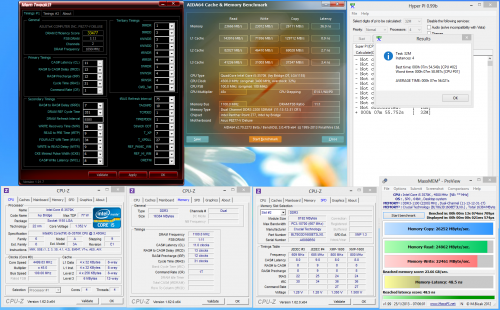
Thus, the Crucial Ballistix Tactical LP series can be recommended to overclockers for its broad compatibility with CPU coolers and high overclocking potential. If you don’t mind increasing their voltage (and power consumption), you can raise their frequency up by almost 40%. Few memory kits are capable of such achievements.
Crucial Ballistix Sport VLP DDR3-1600 2x8GB (BLS2K8G3D1609ES2LX0)
Notwithstanding the less aggressive default timings and smaller heatsinks, the very-low-profile Ballistix Sport VLP modules performed just like their Ballistix Tactical LP cousins. At the default voltage of 1.35 volts they could be clocked as DDR3-1866 with timings of 10-11-11-31-1N. At 1.65 volts we overclocked them easily to 2200 MHz.
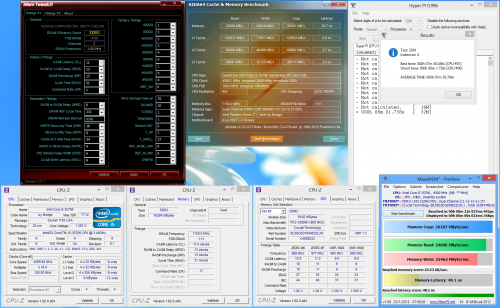
The timings had to be relaxed to 11-13-13-31-1N but that’s normal. High clock rates always go hand in hand with high timings. The Ballistix Sport VLP DDR3-1600 2x8GB kit turns out to be almost identical to the Ballistix Tactical LP DDR3-1600 2x8GB kit in its overclocking potential, suggesting that both are based on the same chips from Micron. It means that you can choose either kit for your overclocked computer, basing on your aesthetic preferences and exact requirements to the height of your low-profile memory modules.
The results of our overclocking experiments are summed up in the following table:

Performance
In our performance tests we checked out the speed of our LGA1155 platform with different low-profile dual-channel memory kits from the Crucial Ballistix series. Each kit was tested in two modes: 1) automatic configuring (every timing is set by the mainboard’s BIOS according to the XMP data) and 2) highest clock rates and best timings (as achieved in our overclocking tests above) set up manually in the mainboard’s BIOS.
First of all we want to run synthetic benchmarks of memory bandwidth and latency. We will use two tools for that. One is the memory test from SiSoft Sandra 2013. Using a multithreaded Stream algorithm, it is perfectly suited to modern memory controllers optimized for multi-core CPUs.
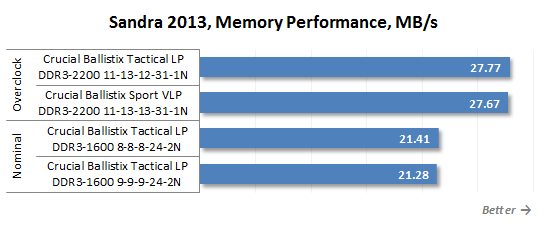
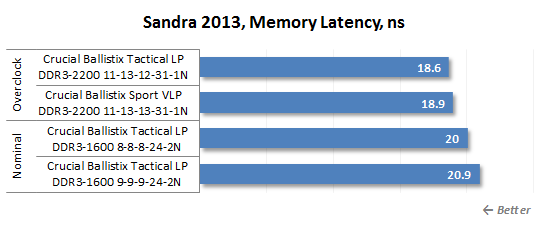
And the other is the integrated test from the ASUS MemTweakIt! utility which issues a single number indicative of the overall memory subsystem performance.
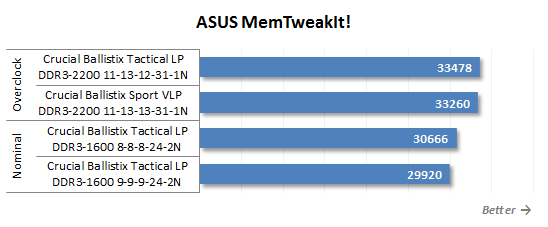
The Ballistix Tactical LP and Ballistix Sport VLP are comparable both at their default and overclocked settings, just as expected since they have identical clock rates in both cases and differ in timings only. Memory timings do not have a big effect on performance in modern computers. Our overclocking helps improve the practical memory bandwidth and latency by a substantial amount – up to 30%.
The SiSoft Sandra 2013 and ASUS MemTweakIt! results suggest that it makes practical sense to be particular about choosing DDR3 SDRAM modules. However, these are synthetic benchmarks which are meant to measure how fast the CPU can work with system memory. Everyday applications are not so memory-sensitive, yet we want to check them out as well.
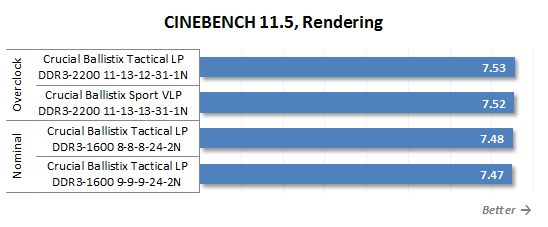
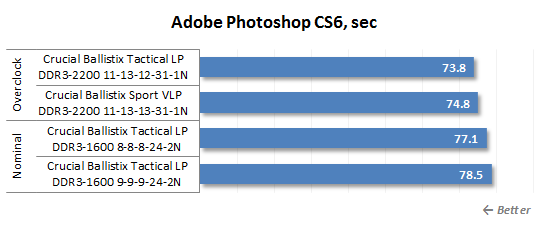
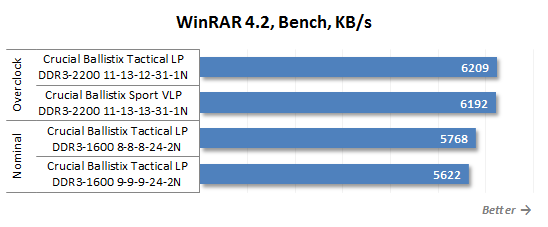
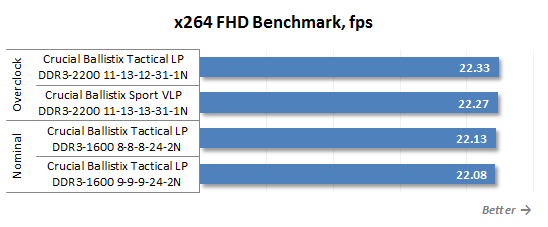
Fast memory is indeed appropriate in some situations, especially when you can achieve the high speed as easily as with the Crucial Ballistix series. Memory subsystem parameters can affect the speed of gaming applications, for example.
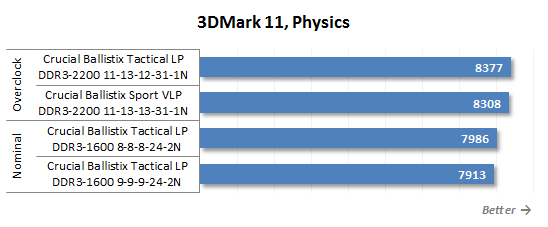
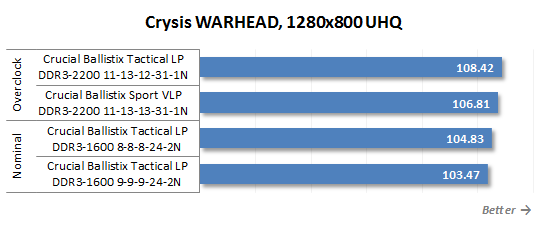
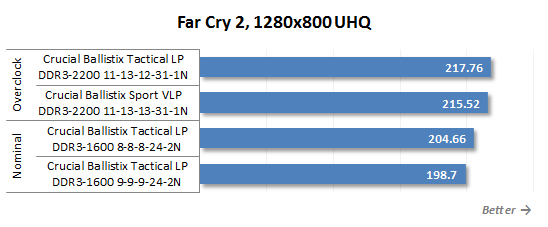
Of course, it is the graphics subsystem that influences the frame rate the most, but the memory frequency is a factor, too. Fast memory can help you improve performance by a few percent. So again, the choice of DDR3 SDRAM is quite important, especially in terms of its frequency.
We usually recommend DDR3-1866 as the optimal choice for today’s computers. Such products cost about the same money as their lower-speed counterparts and thus feature the best price/performance ratio. However, DDR3-1600 SDRAM like Crucial’s Ballistix Tactical LP and Ballistix Sport VLP makes an exception because, as we’ve made sure today, it can be easily overclocked to deliver a substantial (up to 10%) increase in real-life performance.
Power Consumption
Besides its low-profile form-factor, Crucial’s Ballistix modules we’re testing today comply with the DDR3L standard and can work at a reduced voltage of only 1.35 volts. The reduced voltage means reduced power consumption, such memory being especially appropriate for mobile devices or servers. But since Crucial offers its DDR3L SDRAM to enthusiasts, we want to find out the benefits it can bring to desktop users.
First of all, you should be aware that DDR3L must be supported by the mainboard for the memory to work at 1.35 volts. Most mainboards from leading brands available today support DIMM voltages below 1.5 volts, yet you may want to make sure beforehand that your mainboard allows setting 1.35 volts as memory voltage in its BIOS. Our mainboard ASUS P8Z77-V Deluxe supports not only DDR3L but also DDR3U, letting us choose any voltage we like from 1.2 volts and higher with a step of only 0.005 volts.
So we can check out how much power our computer consumes if it has DDR3-1600 working at the standard voltage or 1.35 volts or at overclocked settings with a voltage of 1.65 volts. We use Crucial Ballistix Tactical LP DDR3-1600 2x8GB (BLT2K8G3D1608ET3LX0) for this test.
Our Corsair AX760i power supply supports power consumption monitoring and we use this capability for our tests. In the diagrams below, the computer’s full power draw (without the monitor) is shown as measured at the PSU’s output. It is the sum of each component’s power consumption while the PSU’s efficiency is not taken into account. The computer was running LinX 0.6.4 64-bit with AVX support using the full amount of system memory. To correctly measure the power consumption in idle mode, we enabled all power-saving technologies: C1E, C6 and Enhanced Intel SpeedStep.
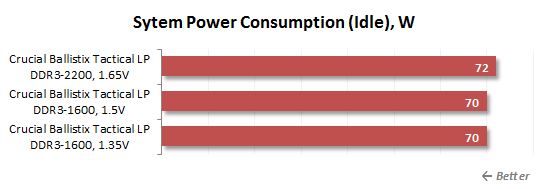
When the computer is idle, DDR3L doesn’t provide any benefits compared to ordinary system memory. The DDR3 SDRAM modules do not contribute much to the overall power consumption. So, changing the memory voltage from 1.35 to 1.5 volts doesn’t produce any visible effect. Overclocking affects the overall power consumption, though. Working at 2200 MHz and 1.65 volts, the memory increases the computer’s power draw by 2 watts. On the other hand, it is possible that it is not the memory modules but the CPU-integrated DDR3 SDRAM controller that consumes more power as it has to work with the memory bus at a higher clock rate.
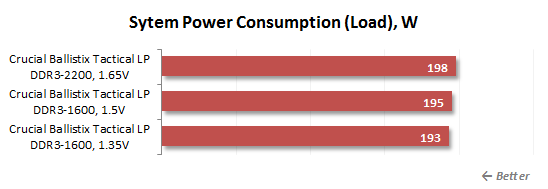
When there’s a high load on the computer, the picture doesn’t change much. The energy-efficient memory doesn’t affect the overall power consumption, especially if there’s an overclocked CPU inside. Compared to ordinary DDR3, DDR3L can save you a mere 2 watts. Overclocking the system memory increases the overall power draw by only 1.5%. Thus, the low voltage of the low-profile Crucial Ballistix modules can hardly be a serious advantage, at least if we’re talking about a typical overclocked computer with an Ivy Bridge processor and a dual-channel memory kit: DDR3L is roughly as economical as ordinary DDR3 SDRAM in this case.
Conclusion
We were not very excited when Crucial offered us to test their new Ballistix Tactical and Ballistix Sport memory kits. How could DDR3-1600 memory, even though targeted at enthusiasts, surprise us? But it turns out that Crucial has come up with original products that can be interesting even despite their unassuming clock rates and timings.
Their main advantage is size. The dual-channel 16GB DDR-1600 SDRAM kits from the Crucial Ballistix Tactical LP and Crucial Ballistix Sport VLP series include low-profile modules which are smaller in height than ordinary ones, which makes them compatible with any CPU cooler. The new memory from Crucial will fit into any DIMM slots and won’t press against the cooler’s heat pipes with their heatsinks however intricate the cooler’s design may be.
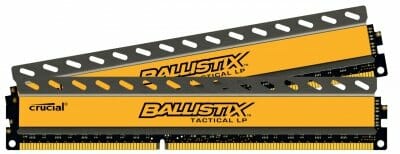
Their second advantage is that they comply with the DDR3L standard and can work at a voltage of 1.35 volts. As we’ve found out, it doesn’t mean much in terms of savings, just one or two watts. But this ensures high frequency potential. As you can substantially increase their voltage, these modules can be overclocked to DDR3-2200 mode, which is quite an achievement. And since the Crucial Ballistix Tactical LP and Crucial Ballistix Sport VLP are not any more expensive than other DDR3-1600 products, they become a more attractive purchase in the end.
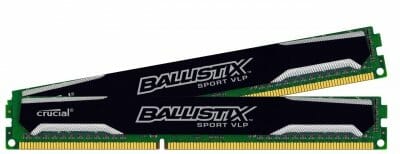
It’s up to you to decide which kit is better. The Ballistix Tactical LP has a nicer heatsink whereas the Ballistix Sports VLP is somewhat shorter.